|

Production from ewes and
their progeny can be
predicted with confidence
from knowledge of the ewe CS
profile. Wool contributes
about 70% in a specialist
wool system and 30% in
a 1st cross lamb
production system to the
gross income of an
enterprise. Breeding
ewes make up more than 50%
of the sheep flock.
Ewe wool should not be
considered a by-product.
Wool growth rates are
influenced by nutrition and
the partitioning of that
nutrition into wool
growing. Variable
nutrient intake by grazing
sheep leads to large
differences in rates of
liveweight change and wool
growth in different months.
Ewes have particularly
variable wool growth rates
due to the added burden of
pregnancy and lactation.
This affects fleece weight,
fibre diameter, length and
staple strength.
The Influence of Feed on
Offer
Feed intake is usually not
limited on Feed on Offer
(FOO) above 2000
kgDM/ha. This means
that wool growth is usually
maximized irrespective of
the stage of pregnancy or
lactation. Liveweight and
wool growth is sensitive to
FOO less than 2000kgDM/ha.
The Influence of Condition
Score
Clean fleece weight and mean
fibre diameter of ewe wool
is closely related to their
condition score changes over
pregnancy and
lactation. Together
with ewe stocking rate the
condition score profile over
the year can be used to
predict the value of the ewe
wool clip in advance.
Ewes in higher Condition
Score produce more wool, but
it is broader. The effects
of changes in ewe Condition
Score (CS) during early and
late-pregnancy have a
similar effect on ewe clean
fleece weight and the
relationship is linear.
- An increase of 1
CS ~ 0.8 kg
CFW. So ewes that
lose 0.5 CS and then
gain 0.5 CS to lambing
will produce similar
clean fleece weight as
ewes that maintain CS
through pregnancy.
- A loss of 0.5 CS in
early to mid-pregnancy
reduces the clean fleece
weight by 0.4 kg in both
single and twin bearing
ewes (LTEM3.1)
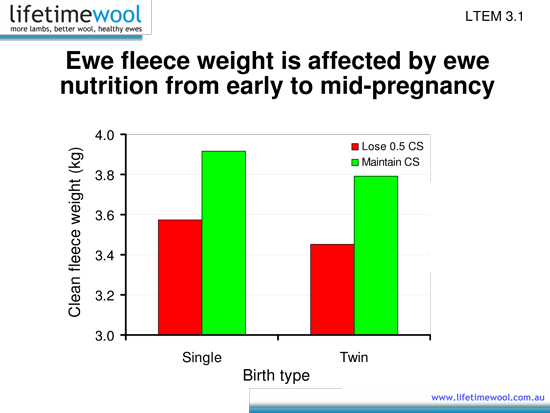
- A gain of one CS in
late-pregnancy will
increase the clean
fleece weight of ewes by
0.8 kg for both single
and twin bearing ewes
(LTEM4.1)
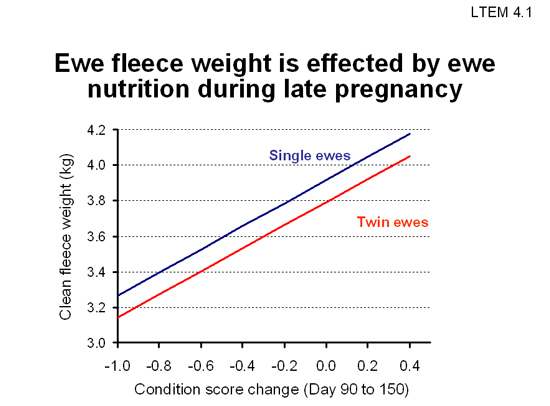
- A loss of 0.5 CS in
early to mid-pregnancy
reduces fibre diameter
of both single and twin
bearing ewes by 0.5m
(LTEM3.2)
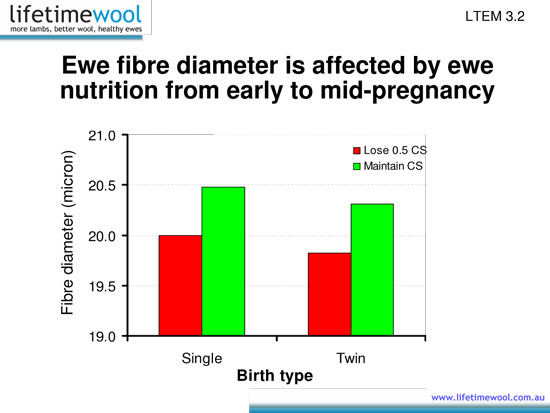
- A gain of 1 CS in
late-pregnancy will
increase the fibre
diameter of the ewe
fleece by
1.0 micron for both
single and twin bearing
ewes (LTEM4.2)
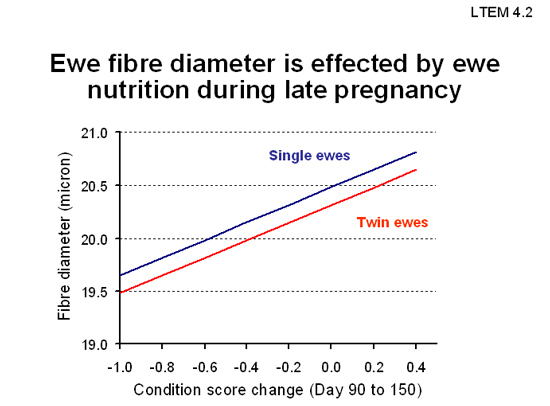
*Early and mid-pregnancy from
the point of joining to Day
90 of the pregnancy (Approx.
Day 10 – 105 from rams in).
Late pregnancy is Day 90 to
lambing.
The Effect of Condition
Score changes on Staple
Strength
The effects of nutrition on
staple strength (SS) are
largely explained by changes
in the variation in fibre
diameter along the staple,
and the key determinant of
staple strength is the
minimum fibre
diameter. A 1µm
change in minimum fibre
diameter is normally
associated with a change in
SS of about 4-5 N/ktex.
The effects of changes in ewe
Condition Score (CS) on
staple strength depend on
the time of the nutritional
treatment and the time of
shearing.
For late winter/spring
lambing ewes shorn in
spring/summer, a loss of one
CS during early and
mid-pregnancy can reduce
staple strength by 5
N/ktex. By contrast,
gaining a CS in
late-pregnancy after losing
a CS in early pregnancy will
reduce SS by another 2-3
N/ktex, so this wool can be
7 to 9 N/ktex weaker than
that from ewes that
maintained CS throughout
pregnancy.
A loss of 0.5 CS in early to
mid-pregnancy reduces staple
strength of both single and
twin bearing ewes by 2.5
N/ktex (LTEM 3.3).
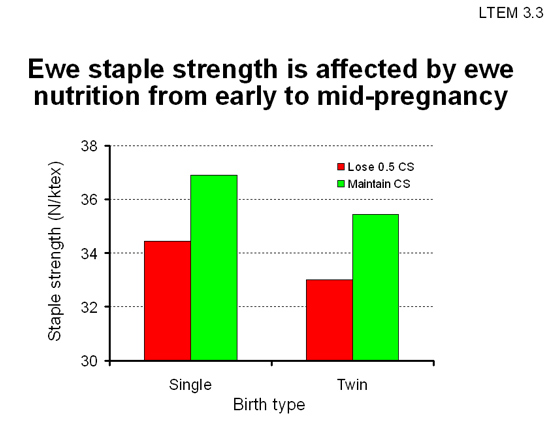
Tools:
ewe
management
guidelines
|